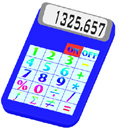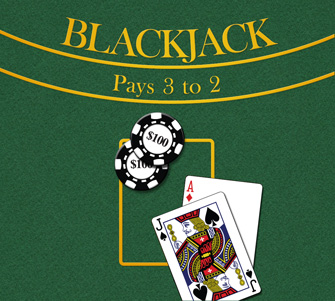The Kelly Criterion and Blackjack
The Kelly Criterion is a method of betting for blackjack players who have a mathematical edge in a wager. The Kelly Criterion maximizes your profit while eliminating your risk of ruin.
The Kelly Criterion is most often used by card counters. The better a player's chances of winning based on the card count, the more the player bets. The size of this bet is determined according to the Kelly Criterion, sometimes known as the Kelly Formula. If the house has an edge in a game, then the Kelly Criterion is useless.
Calculating Risk and Applying the Kelly Criterion
The Kelly Criterion is a mathematical formula used to maximize the growth rate of serial gambling wagers that have a positive expectation. The Kelly Criterion is a model for long-term growth rate.It does not predict automatic short-term success, but the Kelly Criterion does maximize profits by setting the percentage of a player's bankroll which should be bet at each stage of play.
Basically, the Kelly Criterion can be boiled down to this: you should bet a percentage of your bankroll equal to the edge you have at the game. When you raise the size of your bet based on how good the count is in a blackjack game where you're counting, you're putting the Kelly Criterion into action.
What the Kelly Criterion Does Not Do
- The Kelly Criterion doesn't assure you will make a profit. It maximizes your profits when you do win.
- Conversely, the Kelly Criterion doesn't assure you won't lose money. The criterion minimizes the chance you will lose all your money.
- The Kelly Criterion does not help gamblers defeat a house edge. It is meant to help those playing with a positive expectation. It really has no use when playing most casino games, because the house has the edge in most casino games..
The History of the Kelly Criterion
 The Kelly Criterion was developed by John Larry Kelly, Jr. J.L. Kelly worked at Bell Labs in Texas, and was born in Corsicana, Texas.
The Kelly Criterion was developed by John Larry Kelly, Jr. J.L. Kelly worked at Bell Labs in Texas, and was born in Corsicana, Texas.
Kelly began to develop investing strategies according to probability theory. These theories also applied to gambling strategies, too, and these investing strategies are part of what is now called game theory.
John Kelly's friend and colleague, Claude Shannon, made a visit to Las Vegas in the 1960's. Shannon and his wife used the Kelly Criterion to win at blackjack. Claude Shannon and another colleague eventually applied the Kelly Criterion to the stock market, eventually collecting a fortune.
By this time, John Kelly was dead of a stroke. His theory has been applied to gambling with increasing frequency over the years.
The Kelly Formula
The Kelly formula is meant to determine the fraction of your bankroll which you should bet at any given times. The idea is that you find that fraction which maximizes the amount of money you expect to win.
Here is the basic equation for the Kelly Criterion:
f = (b times p minus q) divided by b
There are several portions of the formula which need to be described:
f = The fraction of a player's bankroll which should be wagered. This is the number someone is looking for when using the Kelly formula.
b = This is the odds the player is receiving on the wager.
p = The probability the player will win the wager.
q = The probability the player will lose the wager, which is easily determined in a simple bet as 1 - p. For example, if the probability of winning (p) is 0.50%, then the probability of losing (q) would be 1 - 0.50 or 0.50%.
This would imply an even-money bet. In such an even-money bet, the Kelly Formula can be simplified to f = 2p - 1.
To use the Kelly Criterion, then, a player must be able to estimate the odds, the probability of winning and the probability of losing the bet.
Drawbacks to Using the Kelly Criterion
The Kelly Criterion cannot guarantee a win on gambling. What the Kelly Criterion does is guarantee you will not lose all of your money. It also maximizes your profits when you are winning. The Kelly Criterion is supposed to accumulate a compound interest of 9.06% when used correctly.
The problem with the Kelly Criterion is that it can lead to highly volatile results. You have a 33% chance of losing half of your bankroll before you double your payroll. There have been many attempts to modify the Kelly Criterion to make it less volatile. This led to the creation of Half-Kelly techniques.
The Half-Kelly Criterion
The Half-Kelly Criterion is often used by players who don't entirely trust the Kelly Criterion or their implementation of it. In a casino setting, it is easy to miscalculate the formula. If this leads to over-betting, the formula becomes counter-productive and the player can lose a large amount.
To safeguard against this, some people simply half the bet the Kelly Formula requires. This is called the half-kelly. This eliminates the chances of mistaken over-betting. Of course, the Half-Kelly undermines the original purpose of the Kelly Criterion, which was to maximize the amount won at a casino.
See also:
- 6-5 Blackjack
- Traits of Winning Blackjack Players
- Beat The Dealer Blackjack Book Review
- Card Counting Software
- Millionaire Casino Download
- Blackjack Sites Ordered By Traffic
- Card Counting in Blackjack
- Free Online Blackjack
- Blackjack Weaknesses
- Learning New Blackjack Skills
- Ryan Board Interview
- Bad Ideas in Blackjack
- Pro Blackjack Tips
- Blackjack Decision Making


 Black Diamond Casino
Black Diamond Casino


